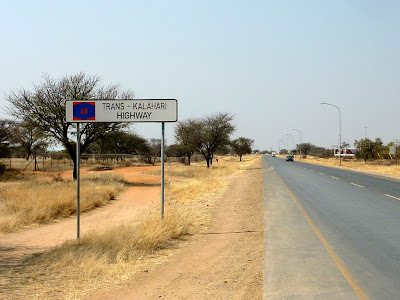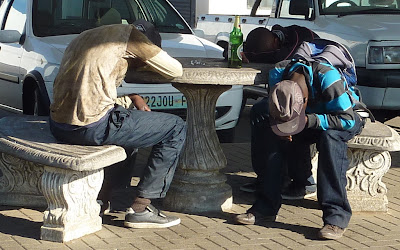12 September 2010
Lesotho was, expectantly, the pearl of this tour. The country, the land, the people and the culture were still pristine. An hour after you pass Maseru, the small capital town right at the border with South Africa you enter into the world of mountains where you're not considered weird if you don't have a credit card and a cell phone.
Great road ...
.. and scenery
From Maseru I took road #A2 and #A3 going close to Mohale dam, through Thaba Tseka and Likalaneng, joining #A1 near Mokhotlong and turning right on #A14 to Sani pass. It is 350 km, the first half is beautifully paved, the rest is a dirt road, sometimes really awful, especially where there were some "upgrade" works. The gradients are high, they don't know anything less than 10% in Lesotho, with excursions up to 18% (once my altimeter measured even 39%, but I will disregard it - the wind probably had some effect on pressure measurement). Fortunately, after every climb, there is also a descent: see the
VIDEO.
Up the Blue Mountains pass
A pic before the downhill
The configuration is very hilly, you're riding up and down all the time. There are 9 bigger passes,
Bushmen's pass (2268m), Molimo Nthuse (2318m), Blue Mountains pass (2634m), Cheche's pass (2645m), Pass of Jackals (2692m), Mokhoabong (2880m), Menoaneng (3014m), Kotisephole (3240m) and Sani pass (2873m), but to come from one to the other there are some "intermediate" climbs not much easier then the real ones. Sani pass marks the border with South Africa and is not actually a pass if you are coming from Lesotho, you are just descending form the pass at 3240 m.
Still ploughing with oxen.
Balaclava, blanket and rubber boots: the Lesotho shepherd.
Typical huts in Lesotho
It's also difficult to find a flat space to put a tent - all the flat parts are either used to grow corn, or are directly by the side of the road or in a few rare river valleys, where there's nothing to hide you from people walking about. I camped twice in Lesotho and both times a big crowd of children gathered by my tent in the morning and after I packed they followed me, running along the bike in their rubber boots, until the road became steep and they got exhausted. It was a lot of fun for me, and, judging from their laughter, for them too (the
VIDEO ).
Children at my morning camp. See the VIDEO Lesotho vista
Basotho village
View from the pass
Day 21: 102 km. Day 22: 87 km. Total: 2942 km.
 I've choosen a particulary interesting itinerary, covering Namibia, Botswana, South Africa and Lesotho. This mini "coast-to-coast" tour in Africa has all the potentials to become one of my favorites.
I've choosen a particulary interesting itinerary, covering Namibia, Botswana, South Africa and Lesotho. This mini "coast-to-coast" tour in Africa has all the potentials to become one of my favorites.

























































